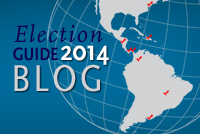2014 Elections Blog: Peru's Municipal and Regional Vote
Around 21 million Peruvians will elect mayors and regional presidents on October 5. Who will win the coveted post of mayor of Lima?
 On October 5, Peruvians will vote in regional and municipal elections. Voters will elect 25 regional presidents—a position similar to that of a governor—195 provincial mayors, and 1,647 district mayors, among other local seats. All positions are for four-year terms. Voting in Peru is mandatory; non-voters are fined and may have access to certain public services withheld. More than 21 million Peruvians are eligible to vote.
On October 5, Peruvians will vote in regional and municipal elections. Voters will elect 25 regional presidents—a position similar to that of a governor—195 provincial mayors, and 1,647 district mayors, among other local seats. All positions are for four-year terms. Voting in Peru is mandatory; non-voters are fined and may have access to certain public services withheld. More than 21 million Peruvians are eligible to vote.
One of the major races is for the mayoralty of Lima. Polls favor Luis Castañeda, who served as mayor from 2003 to 2010; a September 38 IPSOS survey gave him around 54 percent of voter support. The incumbent—Mayor Susana Villarán, who survived a 2013 recall vote—is in second with 13 percent. Salvador Heresi, mayor of Peru’s San Miguel district, stands in third with 7 percent, while former Minister of Transportation and Communications Enrique Cornejo is in fourth with 5 percent. Pollster CPI gives an even more substantial lead for Castañeda in a September 28 survey, with nearly 60 percent compared to Villarán’s 11.5 percent.
Ipsos’ President Alfredo Torres wrote this month that although a win for Castañeda is “virtually certain,” elections in Peru generally tend to be unpredictable. Around 40 percent of Peruvians don’t definitively make up their mind until the last week before the vote, and around half of those don’t decide until election day. A September 6 survey from pollster Vox Populi found that 50 percent of Lima residents had either not decided for whom to vote or said they’d possibly change their decision.
Another race to watch is that of the regional president of Cajamarca, a department with ongoing mining conflicts. Current Regional President Gregorio Santos Guerrero leads the polls—even though he has been in prison since June on corruption charges. Santos supported protests against Cajamarca’s controversial Conga mining project in recent years. Meanwhile, businessman Osías Ramírez is polling second.
The armed forces will deploy 48,700 troops throughout the country to provide security on election day. Also, observers from the Union of South American Nations and the Organization of American States will travel to Peru to monitor the election. And after a slow vote-counting in 2010 drew criticism, the head of the country’s electoral authority promised that this year, 100 percent of results will be available within 24 hours. But if regional presidential candidates fail to reach 30 percent of the vote, they’ll face runoff elections in November. Polls indicate that at least 11 of 24 departments will likely have to hold second-round votes for regional presidents.






